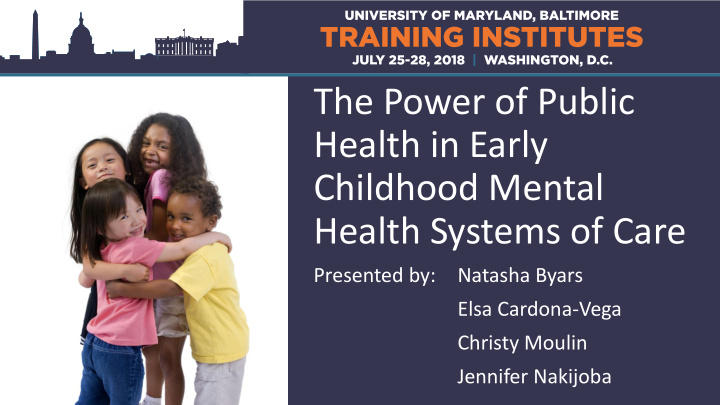



The Power of Public Health in Early Childhood Mental Health Systems of Care Presented by: Natasha Byars Elsa Cardona-Vega Christy Moulin Jennifer Nakijoba
Welcome! Listen to this: What I am by Will.i.am Think about this: What color best describes how you are feeling? What one word best embodies “what you are”? Do this: Take a piece of paper in this color (or the closest we have to it). Write down your word, filling the whole paper.
Agenda 1. Welcome and Introductions 2. Content 3. Small Group Work 4. Large Group Process 5. Closing
Let’s begin with some numbers…
Center on the Developing Child (2017)
Brain Growth
What is Early Childhood Mental Health? Early Childhood Mental Health (ECMH) refers to the developing capacity of the child to: • Experience, regulate, and express emotions; • Form close and secure interpersonal relationships; • And explore the environment and learn; All in the context of family, community, and cultural expectations for young children. Infant mental health is synonymous with healthy social and emotional development. (Zero to Three)
Common ECMH Concerns • Parental stress/mental health • Adjustment and loss (new sibling, loss of caregiver, moving into a shelter, recent immigration) • Behavior concerns • Infant crying • Social development • New parent support • Activity level • Anxiety/extreme shyness/separation anxiety • Adjusting to/managing medical concerns • School concerns (evaluations, communication with teacher, making friends)
10 1. Monitor Health 2. Diagnose and Investigate Essentials 3. Inform, Educate, & of Public Empower 4. Mobilize Community Health Partnerships 5. Develop Policies 6. Enforce Laws 7. Link to/Provide Care 8. Assure Competent Workforce 9. Evaluate https://www.accesskent.com/Health/HiAP/default.htm
The SOC Primary Care Center Model MA Multi-City Young Children’s Mental Health Family SOC Project Partner + Local Health Intensive Care Department Coordinator (Services reimbursed by Medicaid)
Why the Medical Home? • Regularity of well visits in infancy & early childhood (15 routine visits by age 6!) • Relatively high parent trust for child's pediatrician diminishes barriers to mental health care • Powerful, non-stigmatizing point of entry into community-based services • AAP vision of medical home as hub for comprehensive care • Increasing momentum of medical home model
Integration at Service Level Primary Care Visit Young child attends pediatric primary care visit with Caregiver. Primary Care Provider identifies children with social and emotional needs Warm Handoff to direct service team Feedback to Primary Family Partner or ECMH Clinician/ICC introduced Care Providers to Caregiver at end of primary care visit Engagement and Assessment in ECMH Series of visits with ECMH Clinician/ICC and Family Partner to build relationship and identify strengths and needs
– Prevent – . Risk Protective Employment Factors Factors Parents Siblings Peers Child Caregivers Housing
Strategic Partners in Early Childhood Work • Parents and Family • Close Family Friends/Neighbors • Primary Care Provider/Center • Early Intervention Worker • Teachers/School Staff • Daycare Provider • Home Visitors • Mental Health Provider • Community Resources/Agencies • Public Health
The Toolkit: Find it at ECMHMatters.org
The Toolkit: Find it at ECMHMatters.org
Highlight from Section 4
Highlight from Section 2
Highlight from Section 1
Highlights from Section 3
Highlights from Section 3
Highlights from Section 3
Highlights from Section 3
Highlights from Section 3
Highlights from Section 3
Highlights from Section 3
Small group time The goal: 1. ID Sections of the Toolkit you want to spend more time exploring. 2. Draft next-steps for bring pieces of the Toolkit to your own work.
Section 3 1. Enhancing Provider Communication 2. Family Partner Documentation in Medical Records 3. Building Medical Home Systems for Home and Community Visits 4. Integrating Caregiver-Child Mental Health Services 5. Parent Voice in Shaping Medical Home Services/Systems 6. Engaging in Quality Improvement Efforts
Directions 1. Choose a piece of Section 3…or use your own device to select a section from the online version. 2. Move to the table where others are looking at the same piece…or work alone/with neighbor. 3. Use the worksheet if it is helpful or a facilitator. 4. We will come back together to process/share before closing.
Let’s Process 1. What is a next step you feel 85% confident about? 2. Which partners are you going to contact this month? 3. What is your fear/obstacle to overcome? 4. When will you reach out for encouragement?
Thank you for being here! Think about this: What one word best embodies your feelings after this session? Do this: Turn your paper over and write your word. Share: Turn to a neighbor and spend 1 minute sharing, then 1 minute listening.
Recommend
More recommend